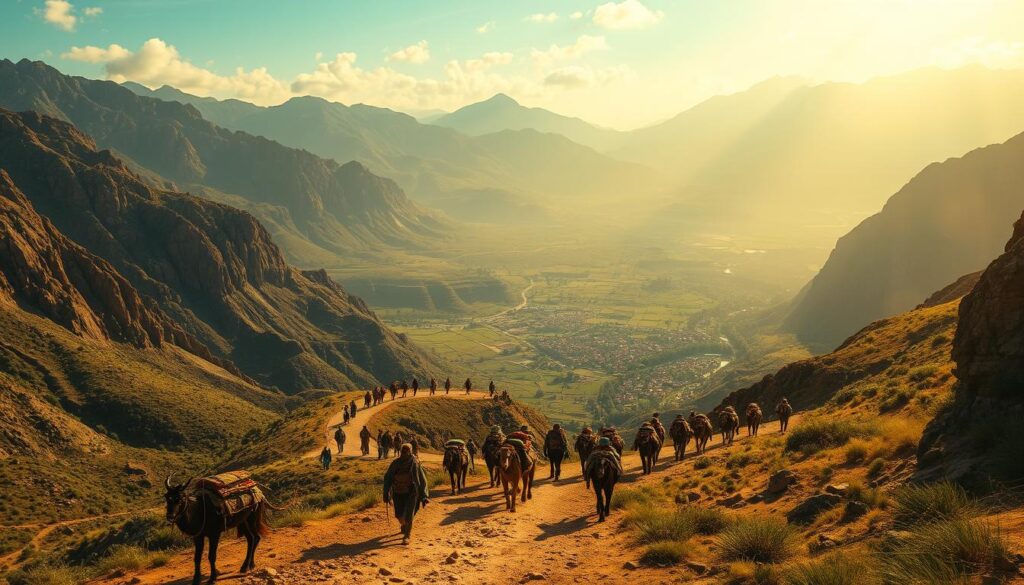Historians recognize the Silk Road as one of the most famous trade routes which passed 4,000 miles across the land. The enormous trade network stretched 4,000 miles between East and West which still influences the world that exists today. The trading routes provided more than commercial transportation since they functioned as essential routes for the exchange of culture and technologies.
Through pathways connecting spices with silk and concepts with inventions numerous distant territories united themselves together. The trade paths performed an essential role in creating economic systems which formed civilizations. The trade routes continue to exert effects on international supply chain management and cultural relations that exist worldwide today.
The article investigates the global world-changing effects of these trade routes. This article analyzes their ancient history followed by their enduring effects and their contemporary relevance.
Key Takeaways
- Trade routes connected distant regions, fostering cultural and economic exchange.
- The Silk Road is one of the most well-known examples of these networks.
- These pathways played a key role in shaping civilizations and economies.
- Goods, ideas, and technologies traveled along these routes.
- Their legacy continues to influence modern logistics and global connections.
An Introduction to Ancient Trade Routes
At a time preceding modern highways early human cultures utilized profound systems to move products along with intellectual concepts across their lands. The first organized commercial networks arose at the start of the Chalcolithic period. Animal domestication particularly of camels and donkeys served as the vital factor for extending commercial trade networks.
Temporary success in travels demanded accurate timing. Ships as well as caravans needed to exercise caution in their travel planning because they had to account for the time schedules and meteorological factors. The method guarded against accidents as it enabled protected transportation of valuable items throughout long distances.
Routed transportation systems received additional improvements from technological progress which included superior carts and advanced navigation systems. The designated trading zones and port facilities transformed themselves into vigorous marketplaces for merchants to swap commercial items including herbs and fabrics. These regional spots held essential importance for transforming different parts of the world into connected entities.
Groups of merchants together with single merchants united their efforts to substantially impact trade networks. The networks they built extended across complete continents through their work. Hierarchical commercial paths established during ancient times provided the basis for worldwide commercial activities as we know them today.
This table demonstrates essential elements about the initial trade routes that developed during that period.
| Aspect | Details |
|---|---|
| Period | Chalcolithic to early Bronze Age |
| Key Goods | Spices, textiles, metals |
| Transport | Domesticated animals, carts, ships |
| Hubs | Ports, market towns |
| Impact | Cultural exchange, economic growth |
The early networks became more than routes for commercial activities. Through cultural exchange and economic growth these networks developed civilizations by their impact on the regional advancement. The networks have left a lasting impact on worldwide commercial activities that remains active and influential throughout the twenty-first century.
Understanding the Role of Trade Routes in History
Global connectivity relies fundamentally on trade routes which served as its foundation since antiquity. These pathways functioned beyond their shipping functions. Various systems controlled economic systems and political operations and social structures throughout extensive periods of time.
Numerous merchants and traders acted as the essential elements needed to link distant areas together. bilgies built through this network facilitated mutual cultural knowledge sharing with technological exchange. The same path taken by traded items allowed ideas along with innovations and traditions to reach every destination.
Geography established the success and failure rates of early networks during this era. Networking activities used rivers as they created trade routes with natural opportunities for connections. Vital connection points between different regions lay within both coastal areas and mountain passes.
International commerce strengthened its relationship with local development practices. Local markets reached their full potential through expanding networks that supported international trade. Civilizations grew successfully because these cultural areas established equilibrium.
A table follows which presents essential historical aspects about these paths below.
| Aspect | Details |
|---|---|
| Role | Economic, political, and social shaping |
| Key Players | Merchants, traders |
| Geography | Rivers, coasts, mountain passes |
| Impact | Cultural and technological exchange |
| Legacy | Influence on modern networks |
The establishment of these maritime routes formed the basis for world connectivity during the present era. The routes established by these ships promote both contemporary logistics systems and global partnership development.
A Look at the Famous Silk Road
The Silk Road created impacts across the world because of its extensive network as a transportation route. The famous path started from Xi’an in China and extended over thousands of miles to reach the Mediterranean region. Culture along with innovative ideas traveled through this transportation route which functioned beyond its basic purpose for commercial product movement.
Origins and Cultural Exchange
Technological and Economic Impact
The Silk Road enabled technology to expand vigorously throughout its areas. Knowledge about creating paper along with discoveries about gunpowder first appeared in Eastern civilizations before their spread into Western territories. Businessmen adapted to new equipment and methods in order to keep their shipments safe during the long-distance journeys.
The route’s architectural system enabled two shipment methods consisting of caravan transports and nautical transport. Flexible operations established this trade route as a vital component of worldwide business. Through its operation the Silk Road functioned beyond transportation of goods since it redesigned economic structures and modified historical events.
Today the route inspires modern logistics systems which continue to build worldwide relationships. Through the enduring legacy of the Silk Road people understand how exchange powers and technology endures.
Maritime Marvels: The Spice and Incense Routes
uncate abundance of seas once functioned as main transportation routes which linked distant territories through maritime commercial ties. The water paths known as the Spice and Incense Routes emerged as historical routes which exerted massive influence. Maritime trade by way of sea routes enabled both commerce of goods and cultural and economic influence between distant lands.

Spice Routes: From Pepper to Colonization
Exotic tastes of pepper and cloves and cinnamon were the main factors that guided operations on the Spice Routes. The European populations held these spices in tremendous value since they served both as preservation agents and flavor intensifiers. The pursuit of these exotic products inspired Europeans to discover new ways of navigation while they mapped routes across the seas. The European trade system eliminated Arab as well as North African transportation brokers to allow direct market access for Europeans. The economic situation began to change dramatically because competition grew between merchants which culminated in establishing colonial rule. Global economic control centered around spice production industries after Europeans bypassed North African and Arab trading routes.
The Incense Route and Its Cultural Significance
The Incense Route operated as the primary pathway that connected Arabian Peninsula with Mediterranean ports. Religious ceremonies relied on the tremendous value of frankincense and myrrh which distributed through this specific trading route. The aromatic resins served as core elements in the cultural practices as well as sacred traditions of diverse societies.
Each designated port on the route transformed into active trading centers. The original trading locations throughout history changed into contemporary city centers whilst keeping alive the memory of this early trading system. Through the Incense Route both trade operations and cultural interactions thrived till they produced enduring effects on the civilizations of the Mediterranean region.
Time has led to the maritime networks’ decline but the strength of their influence persists. Navigation innovations together with economic changes brought by them continue to influence our contemporary world.
The Amber Road and the Evolution of Trade Commodities
Baltic gold also known as Amber made its long journey along the Amber Road. The Amber Road established a critical passage that linked the Baltic Sea with the Mediterranean Sea for trade purposes. Traders transported both amber and precious merchandise consisting of gold along with spices.
The combination of beauty along with medical advantages made amber an object of high value. Traders carried amber pieces through the roads to create jewelry designs and medicine remedies and protective religious objects. Besides amber traders actively pursued the decorative value of gold as a valuable commodity. A variety of goods moved through various active trade markets located at critical locations throughout the road.

The Golden Caravans and the Tea Horse Road
Chinese tea producers interchanged with Tibetan breeders through the Tea Horse Road using tea as a main method of exchange alongside warhorses. A unique trading system emerged from the connection between Chinese tea growers and Tibetan horse breeders on this road. Golden Caravans worked as the primary vehicles for transporting goods through difficult terrains in the trade.

Trade in Tea and Warhorses
Regions needed the Tea Horse Road because it served as their essential connection pathway. The basic tea supply of China served as trade material which Tibetan forces accepted in exchange for their essential war horses. The trade between regions operated for numerous centuries while remodeling both economic systems and local cultures.
The Hengduan Mountains presented substantial difficulties to all merchants operating in the region. The difficult mountainside demanded thorough preparations along with great determination from traders. Safety of goods delivery through these caravans despite high risks resulted in deepening relationships between distant areas.
- The Golden Caravans bridged cultural gaps, introducing new ideas and technologies.
- Strategic stops along the road became bustling hubs of activity, boosting local economies.
- Merchants and individuals played a key role in sustaining this ancient network.
The commercial activities generated substantial economic expansion. The annual amounts of tea and horses acted to drive forward nearby urban development. Traditional methods together with innovative approaches allowed the route to survive throughout WWII alongside other periods.
The Tea Horse Road history continues to thrive into present times. Through trade connections people found power to transform how the world operates. Contemporary logistics systems alongside cultural exchange activities trace their origins to the period when the Tea Horse Road flourished.
Exploring the Salt Route: A Journey Through Time
White gold got its name from salt which played an essential role in ancient economies. The value of salt spread wider than merely improving taste since it served as a vital component for food preservation along with human wellness and monetary systems. Effective management systems for carrying white gold between nations led to substantial cultural progress that extended through time.
The Roman Via Salaria served as one of the most well-known trade routes which the Romans called ‘Salt Road.’ Through this Roman route salt from coastal areas could reach inland territories passing through the Adriatic Sea and ending at Rome. The Roman Empire used the road as its essential life line because it sustained both its economic activities and military operations.
The Economic Value of Salt in Antiquity
The value of salt in ancient economies was tremendous. The preservation of meat and fish required salt because it stabilized the food supply during times of extreme weather conditions or lengthy travels. Salt gained tremendous market value because of its demand in society.
Certain regions utilized salt as an exchange medium to such an extent that they adopted it as their primary payment system. The payment of Roman soldiers with salt resulted in the origin of the term ‘salary’. The economic together with political dominance of the salt trade emerges through this historical practice.
The designated stops transformed into flourishing commercial centers as the trade route progressed. The places prospered through taxation combined with controlled exchange which stimulated local economies’ development. These trading spots eventually developed into booming urban centers which reshaped the historical development of the area.
Below is a table summarizing key aspects of the Salt Route:
| Aspect | Details |
|---|---|
| Primary Route | Roman Via Salaria |
| Key Commodity | Salt |
| Economic Role | Preservation, currency, trade |
| Impact | Infrastructure development, local prosperity |
| Legacy | Influence on modern logistics |
The Salt Route continues to serve as an inspiration for the contemporary systems of trade in the world. Today’s international supply systems emanated from the foundation created during the era of infrastructure and logistics development. The historical business road persists as a demonstration of merchant innovation which continues to endure throughout time.
Crossing Deserts: Insights into the Trans-Saharan Routes
A thriving commercial and cultural route existed in the Sahara Desert throughout history. More than hundreds of years the vast desert land operated as a foundational point which established trade routes between North Africa and sub-Saharan territories. The routes functioned beyond transportation services because they acted as essential paths for cultural traditions coupled with religious exchanges.
Covering the Sahara territory demanded substantial persistence and effort. The Sahara Desert created both climate conditions that were too extreme and long distances that were far reaching. Despite unpredictable Sahara conditions various trading caravans consisting of camel vehicles conducted their operations to transfer gold and salt and valuable materials between destinations. Months were required for these journeys because appropriate planning and strong determination were necessary.
Caravan Tales and Cultural Exchange
During their travels the caravans functioned beyond trade groups because they transported cultural elements alongside intellectual concepts. Along their path they brought fresh technologies along with religious beliefs and customs to each land they crossed. Islam sourced its distribution to West African networks which formed the base of global religious dynamics across that region.
Key goods that included gold together with salt functioned as symbols that represented both power and wealth. Within the Mediterranean region the African gold enjoyed great demand yet without Sahara salt food items could not be preserved. Modern economies gained strength as a result of this commerce and new political agreements together with cultural connections formed between interests.
Modern Reflections on Ancient Deserts
Today we continue to witness remnants of the Trans-Saharan network operation. Modern logistics face similar challenges in arid regions, from water scarcity to harsh weather. Ancient traders demonstrated great ingenuity as they showed how to survive in difficult conditions.
The transportation system demonstrates how different cultural communities linked together with each other during their interactions. Interaction between East Africa and the Mediterranean resulted in the creation of modern civilizations through their mutual exchange of goods combined with ideas. These Trans-Saharan trade passages continue to demonstrate the unlimited capability of trade activities.
Unearthing the Tin Route and Bronze Age Innovations
Ancient metallurgy made a revolutionary step forward with tin extracted from Cornwall. The precious metal led to the creation of bronze products and sailed along the Tin Route between Cornwall and the Mediterranean. Through this trade route civilization prospered because it enabled vital commercial exchanges between different societal groups.
The substantial value position of tin stands as an essential component in any evaluation. ropriate combination of copper with tin yielded bronze which transformed the creation of weapons tools and art. The innovation empowered early civilization development because it shaped both their economic structures and their social systems.
Technology and ideas spread widely due to existing trade networks. Artists and businesspeople operating along the Tin Route exchanged expertise that resulted in progress for metalworking practices. The transfer of technology set the base for innovations to come after it.
Cultural transfer took place through the Tin Route. Products including pottery as well textiles accompanied tin transportation thus spreading novel artistic conventions across regions. The combination of cultural exchange ideas between regions enhanced the diversity of both cultural traditions.
The archaeological research at this trading route has enabled us to learn more about how trading was conducted in the ancient world. Historical archaeological studies show that thriving market areas existed alongside advanced supply chain management systems. Early traders demonstrated remarkable foresight in their ability to explore extensive distances according to research findings.
As a result of global trade on Tin Route its heritage continues to thrive throughout present times. The importance of commerce and innovation on the Tin Route continues to affect contemporary industry landscape. Ancient trade strategies for the world continuously live on through this historic trade route.
Historical Routes: Traveling Ancient Trade Paths in Modern Times
Ever since ancient times humans have used pathways that transformed into digital roads to shape the world through trade. The original methods of transporting spices and silk across continents have developed into advanced worldwide networks. Modern commercial operations maintain essential elements which guided the original trading systems.
Continuities and Modern Influences
The logistics systems of contemporary times originated from ancient commercial trading operations. Modern logistics operates through advanced technology in a similar way that merchants used to travel through mountains and deserts. The modern world has substituted the historic control systems which depended on taxation and monitoring with digital tracking alongside data analytics.
Trade networks share a fundamental function which depends on merchants. Sustaining trade was possible only through the use of individuals and groups in years past. The modern business sector exists as the contemporary form of the historic merchants who link producers with consumers all around the world. Although trade networks became wider the fundamental trading concept stayed unchanged.
The modern world views transportation systems differently because of the advancements in digital technology. Computers and mathematical programs now administer supply chain management thus eliminating the need for physical transportation routes. The modernization of trade through technology improved both speed and efficiency yet needs proper supervision to function properly.
Below is a table comparing ancient and modern trade systems:
| Aspect | Ancient Systems | Modern Systems |
|---|---|---|
| Transport | Caravans, ships | Airplanes, trucks, ships |
| Control | Taxation, monitoring | Digital tracking, analytics |
| Network | Local hubs | Global supply chains |
| Impact | Cultural exchange | Global commerce |
The legacy of ancient trade is evident in today’s global economy. From the Silk Road to digital highways, the world remains interconnected. The blending of traditional paths with contemporary innovations ensures that trade continues to shape our lives.
Maritime Trade Networks and Their Enduring Legacy
For countless centuries the oceans served as global trade lines which linked remote nations. Maritime networks have continuously played an essential role since coastal voyage beginnings until modern advanced systems which have shaped the world. Seafaring routes allowed complete exchanges of goods together with cultural items and intellectual knowledge over extensive geographic regions.
Throughout ancient eras ships traveled the coastal waters to carry spices together with textiles and precious metals. Throughout multiple centuries the initial sea trading activities grew into extensive oceanic logistical systems. Through the Maritime Silk Road Asia was linked to Europe which allowed both cultural and economic relationship development.
The trade routes required ports as well as canals to function as central gathering points. Both Venice and Alexandria blossomed into major commercial entities which bridged various geographic areas. The Suez Canal along with other constructed canals played a crucial role in modern global trading because they shortened distances and reduced expenses for world trade.
Qualified traders supported maritime networks through their ships. Due to their expertise in navigation and logistics they successfully transported merchandise safely. The maritime world experienced a revolution in travel reliability and efficiency because of the compass innovation and improved ship design developments.
These unique maritime routes continue to exist as evidence in the present society. The present shipping routes utilize comparable paths with ports being crucial for sustaining international trades. Techniques and maritime concepts from past centuries support the current processes used for international sea transportation.
Through coastal trading in the beginning to modern maritime logistical systems in the 21st century maritime networks have created permanent global effects.
Logistics Then and Now: Comparing Ancient and Modern Trade Systems
Throughout the centuries the logistics system has changed substantially but basic principles of merchandise movement persist. The Silk Road together with modern shipping lanes serve to establish effective paths between producers and consumers.
During ancient times people used physical roads together with manual labor for logistics operations. Modernity has revolutionized the manner in which supply chain management functions. Trade evolution will be analyzed starting from ancient trails before discussing the developments that transformed road infrastructure into what we use in present times.
Technological Advances in Transportation
Throughout centuries the transportation sector has developed remarkably. People used to move goods through the transport of camels together with carts while ships were also employed. The transportation techniques at that time operated at a slow pace while remaining confined to geographical boundaries. Travelers who must cross deserts or mountains faces delays of several months.
The contemporary transportation systems deliver products at superior speeds with maximum operational efficiency. Today’s trucks combined with planes along with cargo vessels enable companies to transport their goods worldwide within a few days. The addition of GPS alongside automated vehicles has enabled the transportation sector to compete with fewer expenses in addition to shorter delivery times.
- Ancient methods: Camels, carts, and ships.
- Modern methods: Trucks, airplanes, and cargo ships.
- Key innovations: GPS, automated vehicles, and digital tracking.
A Look at Digital Systems and Supply Chains
Digital technology has revolutionized logistics. Ancient traders both relied on local transmission of information and cartographic documentation. Enterprise Resource Planning software systems act as digital managers which oversee all supply chain operations in the current market. The systems deliver current information that drives effective operational performance.
Amazon alongside other companies employs sophisticated algorithms that detect product demand while making their delivery routes as efficient as possible. Technological advancements during the past years did not reach this degree of operational accuracy.
Below is a comparison of ancient and modern logistics:
| Aspect | Ancient Systems | Modern Systems |
|---|---|---|
| Transport | Camels, carts, ships | Trucks, airplanes, cargo ships |
| Control | Manual monitoring | Digital tracking, analytics |
| Efficiency | Slow, limited by geography | Fast, global reach |
Ancient logistics systems continue to motivate modern logistical operations conducted today. Since the Silk Road era until digital highways the trading system has progressed through time without altering its essential innovative nature.
Conclusion
Today’s connection and trading systems function because of ancient networking systems which persist in our modern age. Early pathways starting from the Silk Road extended toward maritime networks which eventually developed into current commercial systems. Despite being in the past they created cross-cultural understanding combined with technological innovations that continue to affect modern cultural and tech development.
The progression of these routes transformed physical roads into digital supply chains after an extended period. Their basic function remains constant because they serve to unite peoples with locations. Two cities known as Venice and Xian both functioned as commercial centers which served as economic intersections similar to contemporary metropolitan areas.
The networks create consequences that surpass economic effects. Through their operations they molded cultural influences which spread innovations throughout multiple continents. Rivers and ports functioned as vital connections for commerce just like the vital connections used in present-day logistics systems.
Future lessons apply from the earliest networked societies that existed in the past. Human ingenuity created networks which demonstrate how we transform any length into connectivity that promotes worldwide relationships between people.



